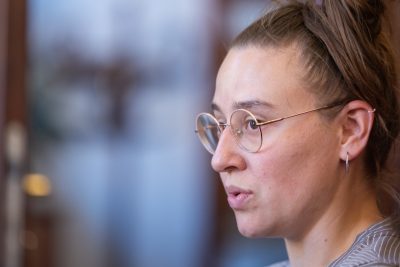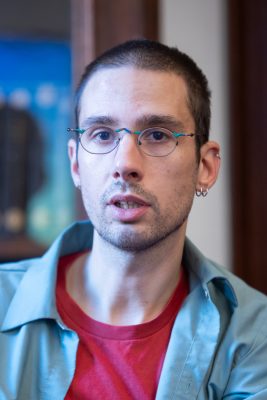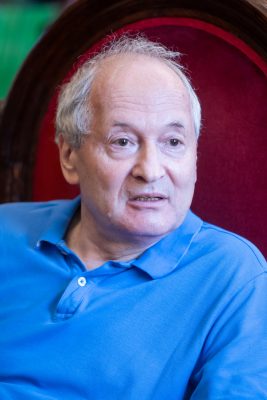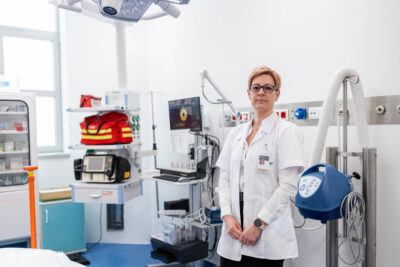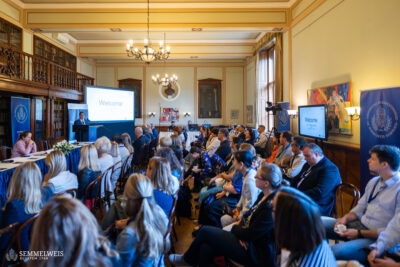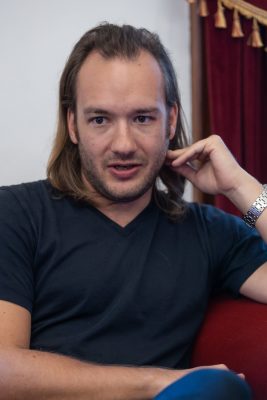 „Based on current trends, we should expect that half of the adult population will die from cancer, and that we will be affected by cancer either ourselves or through a family member’s illness. However, we still cannot talk openly about such a fundamental issue. The diagnosis of cancer, or even the suspicion of cancer, is a stigma, like a mark that, if you have it, stays on you for life, even if you are cured. It’s surrounded by fear, it’s a taboo, something that’s not appropriate to talk about. If we suspect someone has cancer, we don’t even dare to ask. Communication is hindered by the fact that the terminology used by doctors is incomprehensible to lay people, which also feeds their fear. Our project aims to break down these taboos by not using traditional patient education tools, but by involving the people concerned, professionals, students and artists in order to approach different aspects of cancer and show the various perspectives,” said Dr. Richárd Kiss, explaining the concept of the project. The basic idea is that the artists involved will use their own visual tools to make the human aspects of the disease tangible, bringing together all those affected in different ways – patients, oncologists, pathologists, students – and we expect that the visual arts used as a common language, will help to break down taboos,” the pathologist explained.
„Based on current trends, we should expect that half of the adult population will die from cancer, and that we will be affected by cancer either ourselves or through a family member’s illness. However, we still cannot talk openly about such a fundamental issue. The diagnosis of cancer, or even the suspicion of cancer, is a stigma, like a mark that, if you have it, stays on you for life, even if you are cured. It’s surrounded by fear, it’s a taboo, something that’s not appropriate to talk about. If we suspect someone has cancer, we don’t even dare to ask. Communication is hindered by the fact that the terminology used by doctors is incomprehensible to lay people, which also feeds their fear. Our project aims to break down these taboos by not using traditional patient education tools, but by involving the people concerned, professionals, students and artists in order to approach different aspects of cancer and show the various perspectives,” said Dr. Richárd Kiss, explaining the concept of the project. The basic idea is that the artists involved will use their own visual tools to make the human aspects of the disease tangible, bringing together all those affected in different ways – patients, oncologists, pathologists, students – and we expect that the visual arts used as a common language, will help to break down taboos,” the pathologist explained.
The EUniWell Seed Founding Programme project started with a series of workshops in the autumn, with bi-weekly two-hour meetings with a flexible theme based on the dilemmas raised during the discussions. For example, at the first workshop after the introductory session, participants were guided through the process that takes place in a pathology institute, a key institution for the diagnosis of cancer, from the receipt of a histological sample to the final diagnosis. As the project leader explained, no layman knows what happens there, how complex the actual process is, involving up to a dozen specialists, and why it takes up to two weeks, from biopsy sampling to the histological section and pathology report. He added that the pathologist uses his pattern recognition skills to reach a diagnosis by visual examination of the histological section of the sample, which is very impressive.
While we can actually see the patient’s disease with our own eyes, he or she is not usually faced with it directly, as in many cases there are no external signs of cancer, and this hidden aspect reinforces the taboo
– the pathology candidate stressed.
„Bridging the gap between medical language and lay language will help to break the taboo. In particular, it is important that patients are able to interpret their medical reports, since thanks to EESZT they can now usually read it before they go back to their doctor. A medical report is about the patient, it describes his or her condition, so it is essential to understand it, which is why one of the sessions is a nomenclature session,” explained the project leader, adding that this session clarifies concepts and their meanings, clearing up confusion, codes of concern and vocabulary choices.
„There will also be an opportunity to look at coping mechanisms, how people experience their illness, as well as the differences arising from different roles, including, for example, how doctors react in case of their own involvement, and whether they choose treatment according to other criteria than those recommended to their patients,” added Dr. Richárd Kiss. He also noted that cancer survivors are also divided on how involved they want to be in their own recovery. Some people are happy not to have seen the full difficulty of the road to recovery, so they could focus on the next step only, while others want to become experts on their own disease, understand and follow the course of therapy as an equal partner to their doctor. In addition to all this, mental and psychological aspects will also be on the agenda, with the involvement of mental health professionals.
The cancer taboo project involving about 20 people includes, in addition to the pathologist, 2 curators, 2 clinical oncologists, 2 patients, 6 artists, 4 medical and psychology students, many of whom are engaged in multiple roles, either themselves or through family involvement, and can therefore represent multiple aspects. In fact, the involvement of some group members span generations, according to Dr. Richárd Kiss, as there is someone who gave birth to two children while suffering from leukaemia. One of them is now 18 years old, and wants to become a student at Semmelweis University next year. It is part of her mother’s identity that she has leukaemia, as she has endured it all her life, even though society thinks of the disease as a terminal diagnosis,” explained the pathologist.
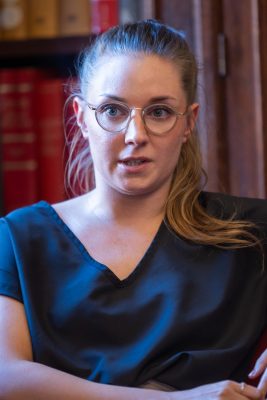 As for the artists’ role in the project, Eszter Dalma Kollár, one of the curators, said that the artists participate in the workshops and create new works of art using their own tools to reflect their experiences. The creative process will begin after the workshops are completed in December, and the artworks will be put together in an exhibition by April, which will be open to the public either by appointment or during public programs in the lobby of the Department of Pathology and Experimental Cancer Research. A bilingual publication on the taboo-breaking approach, the workshops and artworks will be produced as well.
As for the artists’ role in the project, Eszter Dalma Kollár, one of the curators, said that the artists participate in the workshops and create new works of art using their own tools to reflect their experiences. The creative process will begin after the workshops are completed in December, and the artworks will be put together in an exhibition by April, which will be open to the public either by appointment or during public programs in the lobby of the Department of Pathology and Experimental Cancer Research. A bilingual publication on the taboo-breaking approach, the workshops and artworks will be produced as well.
Moreover, the EUniWell project has an international dimension with workshops taking place in Italian, Spanish and Swedish universities, but without the involvement of artists. Throughout the project, online meetings will allow participants to exchange experiences from different locations, revealing the cultural differences and universal human aspects of the taboos surrounding cancer, regardless of country.
The connection between the arts and diseases with a scientific background is unprecedented at the national level, the curator pointed out.
Dr. Richárd Kiss mentioned further plans to organize a live lecture with the participation of partner universities, and to put the educational material on the documentation of the workshops and creative process into the curriculum, so that students could access the knowledge gained during the program year after year.
Tabooing, the breaking of taboos, the representation of bodily sensations and their social acceptance is only a partially new theme for the artists involved in the project. Zsuzsi Simon, for example, has already participated in an exhibition that reflected on the collection of the Semmelweis Museum of Medical History, and as she explained, her works aim to ensure that the artistic representation of cancer patients is not merely the visualization of a mutilated body. Dániel Máté has previously demonstrated cellular changes in energy and calorie consumption with his own tools. Ferenc Markovits, a cancer patient and the creator of a taboo-shattering podcast series on cancer called Rákeltérítő, confirmed that his own fears were minimized when he was finally able to talk about his disease, which for years he had not been able to communicate openly even with his family. It was also a huge help for him when he was confronted with a microscopic, cellular image of his own cancer at a workshop at the Department of Pathology, which he never imagined could be so spectacular to look at, he said. That is why he believes it is of utmost importance to create more awareness-raising projects, since this would significantly reduce the fear that grips those affected. „Taboos need to be challenged at various points, and this is a very effective point of attack,” he stressed.
Anita Szepesi
Translation: Viktória Kiss
Photo: Bálint Barta, Attila Kovács – Semmelweis University
